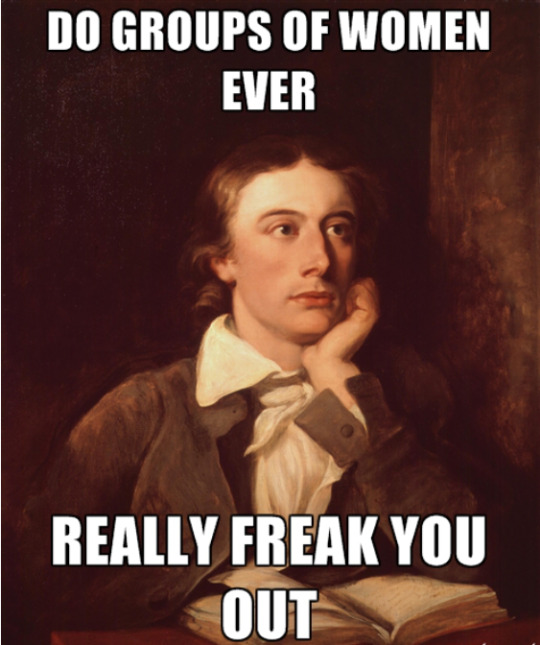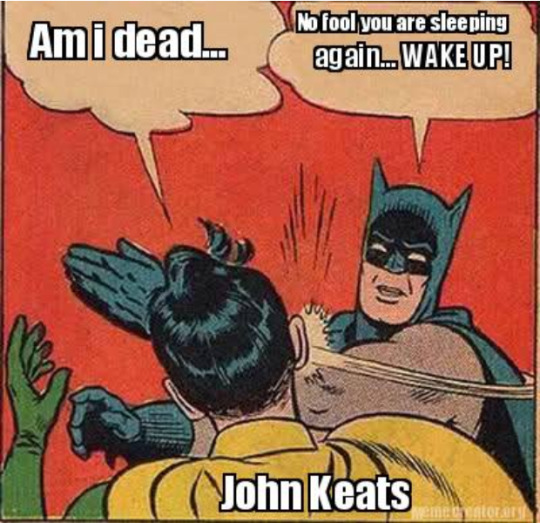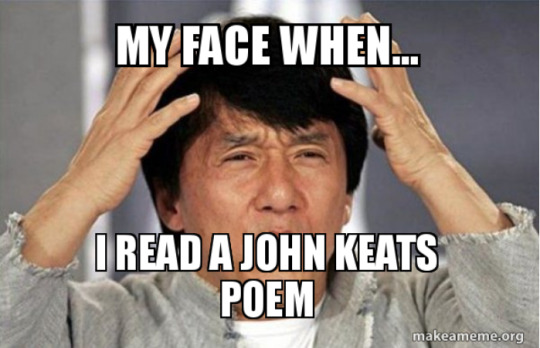Photo

The Angel by William Blake
We believe that the writer speaks of how her beloved went away when he realized that she was keeping him from true joy by sorrowing in his arms
0 notes
Photo

Love's Secret by William Blake
This excerpt clearly resembles the pure feeling of romanticism. Hopelessness, sadness, anguish. The strong love for someone silently taken away by anyone else, and at the end, there's nothing else to do but accept and love even more in silence.
0 notes
Photo

Ode to a Nightingale by John Keats
From our point of view, this part of the poem talks about how death is an easy escape to the darkness of life. The speaker finds comfort in the nightingale's song but at the end he/she finds himself/herself back into his/her loneliness. Although he/she feels calmed with the Nightingale's song, at the same, it turns his/her mood even darker and he/she feels it is a good moment to get rid of the pain and end his/her life.
0 notes
Photo

Ah! Sun-flower by William Blake
Sunflowers: always following the sunlight, and when they cannot see it, they turn to each other. Blake observes this in nature and compares it with a traveler's life, someone who seeks their aspirations to become reality.
0 notes
Text
QUESTIONS FOR ANALYZING #2
What potential do you see in the poem (s) as sources for didactic activities in the class? How would you exploit them in your classroom? Try to be specific when describing the activity and what aspect you would cover in your classes.
In the case of the two poets that we chose, we think that they can be very helpful in teaching vocabulary and giving examples of the well-known figures of speech. Poems have the characteristic of containing not one, but several figures of speech on their verses, such as metaphors, anaphoras, hyperboles, or alliterations. By knowing this, we can think of two ways of implementing these poets and their texts in the classroom.
First, we are thinking of a class around an A2 level, around 10th or 11th grade where in their language course they are going through the figures of speech units. We think that we could take advantage of their current knowledge about the topic and (if the English textbooks apply) make a connection with the English language using the poems of William Blake. As a romantic, Blake is one of the greatest poets of the movement and their poems speak for themselves when one’s reading them. Although Blake’s poems are indeed masterpieces, it is true that many of them are rather short and not that complicated to understand as other exponents of the romantic era. That’s why we are thinking of using some of his poems to replicate the use of figures of speech, like in the angel: “I dried my tears, and armed my fears”, where the use of alliteration is present during almost the whole poem. Also, following the same text, we can find metaphors such as “the angel”, which can be interpreted as a person who the writers love. At the same time, we have hyperboles present too, like in Love’s Secret: “he took her with a sigh”.
We consider that Blake’s poems are outstandingly beautiful and they carry a lot of meaning, representing the hopelessness and the constant despair that romantics of that time were characterized for. Moreover, the use of the figures of speech in his poems are not too hard to catch, and we think that combining them with their language course we can encourage them to build a better understanding of the figures and reinforce their vocabulary knowledge.
A fun and simple way to assess the students’ knowledge and improvement regarding this content would be a matching activity, in which there would be a column A with different quotes from the poems already reviewed in class, and a column B with different figures of speech (metaphor, alliteration, simile, etc.). The idea of this activity is to encourage the students to analyze and recognize the figures of speech in context and without it. By doing these activities, the students will be able to automatize their analysis, which will enable them to improve their reading comprehension skills.
Secondly, we chose John Keats, who is one of the seminal exponents of romanticism. He has three of the most iconics and finest poems written in the English language. In this case, Keats has poems full of figures of speech, but the poems themselves carry a lot of complicated words that can lead any reader to confusion. That is why we are thinking that we can use his poems for teaching vocabulary in higher levels of education. Maybe in a bilingual school in 12th grade, where students are on a B2 level, or in a college level, such as translation and interpreting programs or EFL teaching programs, where the vocabulary input is required even more. For example, the quote “Dance, and Provencal song, and sunburnt mirth!” from the poem: Ode to a Nightingale has three somewhat complicated words which can easily be unknown for medium level of proficiency. These three words are only one of many examples in the same poem. Many verses contain words of high difficulty, making them perfect for raising vocabulary awareness and knowledge. Another example of this would be “Are sweeter; therefore, ye soft pipes, play on; Not to the sensual ear, but, more endear'd, Pipe to the spirit ditties of no tone”.
To be honest, we think that the first scenario would be more achievable, because of its simplicity compared to the later one. It is true that knowing vocabulary at an intermediate or advanced level is important, but it is also true that these words are rarely used nowadays. Most of the words are sophisticated and almost non-usable in everyday conversations, so it would be for pure knowledge of the language rather than the pragmatic use of the words.
However, this does not mean that the poems do not have use in the classroom. For example, if you were to teach the language from two centuries ago, you could well use these poems to show how the language has changed throughout the years. This could be done by making small groups and assigning different poems with a lot of examples of vocabulary to them. The students should look for the words present in the poems and at the same time work on the definitions of these words. They would be supposed to present the findings of the words to the class and create sentences using the words. Vocabulary is learnt by use and repetition, but these words can hardly be used on a daily basis, so it is better to work on activities that require searching, presentation and application to written sentences.
0 notes
Text
QUESTIONS FOR ANALYZING #1
Does the poem (or poems) challenge any established meanings of concepts or principles of the times in which they were written and /or your own? How do they do it? Use quotes from stanzas where you see those challenges represented.
The poem “Ode to Melancholy” by John Keats talks about dealing and coping with sadness, addressing specifically the things that the reader should and should not do in the process.
No, no, go not to Lethe, neither twist
Wolf's-bane, tight-rooted, for its poisonous wine;
Nor suffer thy pale forehead to be kiss'd
By nightshade, ruby grape of Proserpine;
In this extract from the first stanza, the narrator advises the reader regarding what not to do when feeling sad. Despite your state of deep sadness, you should not drink from the waters of the Lethe river (According to Greek mythology, the Lethe waters cause memory loss). In the second, third, and fourth verses the narrator tells the reader not to poison himself/herself and not to have contact with deadly plants (wolf’s-bane and nightshade plants). In simple words, he tells not to self-harm you if you feel doomed but to thrive in spite of the adversities.
In general terms, the poem states that we should embrace melancholy and not to fall in a permanent state of despair, because the pleasant or joyful moments in our lives are inextricably linked to sadness.
She dwells with Beauty—Beauty that must die;
And Joy, whose hand is ever at his lips
Bidding adieu; and aching Pleasure nigh,
In this part of the third stanza, it is mentioned this inseparable connection between beauty, joy, pleasure, and sadness.
This vision towards these concepts is a distinctive factor in John Keats’ poetry. He based most of his poems on emotions and he had a clear vision of love, beauty, and melancholy. In the Romantics movement, it was common to talk about somber feelings, with a melancholic tone.
We consider that, generally, our society does not take sadness or melancholy as something positive or something to be glad for; on the contrary, people usually feel depressed when they face hard times. People are not hopeful whatsoever when it comes to experiencing these bitter feelings, especially if we think in the reality we are currently living. It is almost impossible to think positively when we are facing a terrible pandemic, high mortality and unemployment rates, confinement, stress, anxiety, among others. For that reason, there is a clear opposition between the poem’s interpretation/meaning of the concepts previously mentioned and our modern society’s vision.
0 notes
Video
youtube
Fun Fact #7
The poem “The Tyger” by William Blake was referenced in an episode of Batman: the animated series called “tyger, tyger” (you can hear Batman reciting this poem at the end of this video)
To watch the full scene, Click Here!
0 notes









